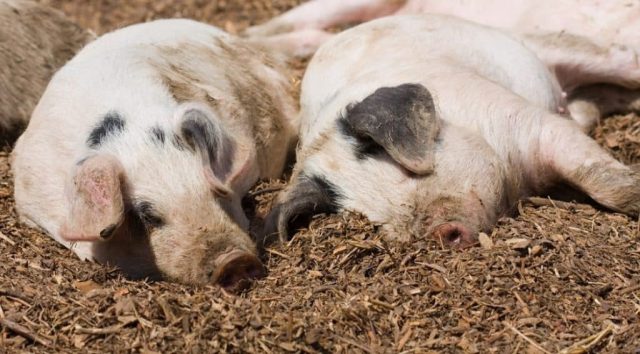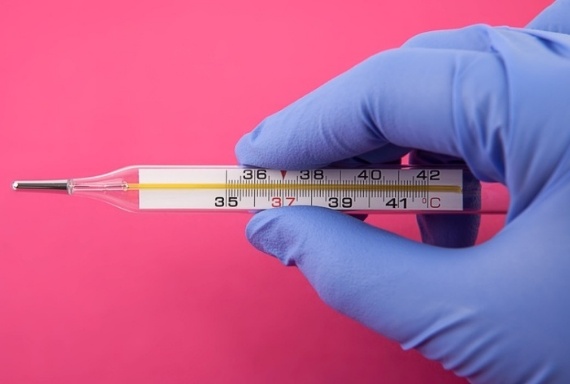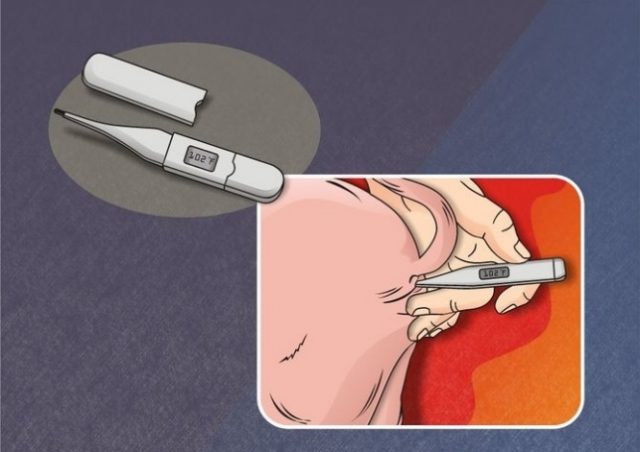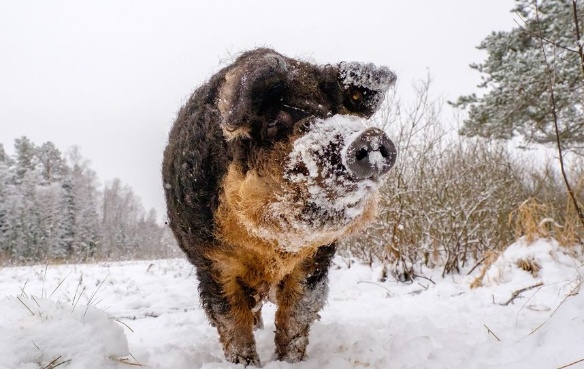Content
A pig's body temperature is the first signal of disease. Almost all serious illnesses are accompanied by high fever. But there are also those that are characterized by a decrease in temperature. The latter are usually not contagious, but can also lead to the death of the pig.
What is considered normal temperature in pigs?
You can immediately say that the normal temperature of small breeds of pigs is the same as that of large breeds. Animals really have this interesting point: the smaller the mammal, the “hotter” it is. But this does not apply to pigs. With the possible exception of just mini pigs. Not Vietnamese pot-bellied pigs, which are not much inferior in weight to large pigs, but real mini-pigs.The latter were bred specifically for decorative purposes, are very small in size and have a lot of genetic problems. The body temperature of such decorative pigs can actually be half a degree higher.
All other breeds, including Vietnamese pigs, body temperature normally ranges from 38 °C to 40 °C. Pigs hold the record for temperature among domestic animals. They share first place with sheep and goats. The piglets try not to disgrace their parents.
What is the normal temperature for piglets?
It is often more important for the owner of a sow to know the normal temperature in piglets than in the sow, so as not to miss the onset of “childhood” diseases. Here again the principle common to all mammals applies: young animals are always hotter than adult animals. Accordingly, normally the body temperature of piglets is in the range of 39-40.5 °C.
And here you should not confuse the internal temperature with the external one. The skin is an organ whose function is thermoregulation. In cold air, it becomes cool, as blood from the epidermis goes inside to retain heat. In the heat, the skin becomes hotter than the internal organs. It is heated by blood that “rises” to the skin to give off excess heat, and by excessively warm air.
In pigs, thermoregulation is carried out in a similar way, adjusted for subcutaneous fat. Young pigs do not yet have sufficient fat thickness and are more sensitive to environmental conditions. Therefore, the temperature of the piglet's skin depends quite strongly on the temperature in the room. The colder the room, the more the pig freezes, and the colder its skin.
Signs of illness
For preventive purposes, you need to measure your temperature at least once a week. Daily inspection helps to identify deviations in the behavior of animals. Such deviations often arise as a result of illnesses and are sometimes noticeable only to the owner who knows his animal well. If a choleric pig, constantly testing the strength of the fence, suddenly stops dismantling its pen, it is worth checking its well-being. Or a phlegmatic person, perked up only at the sight of food, suddenly rushes around the paddock. Most likely, the source of such excitement is not a good mood.
Obvious signs of problems in which a veterinarian is called on the way from the pigsty to the house:
- apathy;
- strong excitement;
- rash on the body;
- diarrhea;
- constipation;
- uneaten food;
- vomit;
- muscle tremors;
- unsteadiness of gait;
- hard breath;
- red eyes;
- rapid heartbeat;
- hot snout and ears (can be like this immediately after waking up);
- dull stubble standing on end;
- attempts to burrow into the litter.
You can intimidate the doctor with something serious, otherwise there is no guarantee that he will come quickly. While the veterinarian is driving, you need to have time to bring a thermometer from home and measure the temperature of suspicious pigs.
List of possible causes of temperature rise
There is only one reason for the increase in overall body temperature – the body’s fight against infection. But there are a lot of diseases that can be caused by pathogens and viruses. Any infectious swine disease included in the list of reasons.
The body temperature of a pig increases:
- for complications after castration, when the wound begins to fester;
- gastritis;
- gastroenteritis;
- other internal non-communicable diseases.
Most often, any serious inflammatory process is accompanied by an increase in general body temperature.
How can you measure the body temperature of a pig and piglet?
You can measure the temperature of any animal with a high degree of reliability only by inserting a thermometer into its anus. Any other methods give a high percentage of error. Measuring from a distance using an infrared sensor only tells how hot the surface of a mammal's skin or fur is.
Measurement methods
In pigs, temperature is also measured at the anus. But animals are nervous and do not always trust their owners. It’s good if the pig calmly allows you to insert a thermometer into its anus. But if she is half-wild, it is more difficult.
How to measure a pig's temperature correctly
You have to hope for the best, but expect the worst. In an ideal situation, the pig’s tail is raised, a thermometer is inserted into the anus and the required time is waited, not forgetting to hold the thermometer.
The anus has an unpleasant feature of “sucking” objects inserted too deeply into itself. A pig can “eat” a deep-immersed thermometer with its rear end. After this, the sphincter will close, and it will be impossible to get the thermometer. There are recommendations to secure a ribbon or thin rope to the top of the thermometer with an adhesive plaster. Then using this ribbon it will be possible to remove the thermometer from the animal’s anus.
The video below shows the "ideal" measurement of a pig's body temperature using a mercury thermometer. The owner's only mistake: he lets go of the thermometer. He was lucky that the pig did not pay attention to such an oversight. Some animals simply push the measuring device out. This is better than if they are “sucked in,” but the thermometer may break.
An imperfect temperature measurement will occur if the pig is semi-wild. A relatively small pig can still be caught, knocked down and held by force. This will no longer work with an adult pig. Such a pig's legs are tangled and thrown to the ground. They wait until she calms down and carefully insert a thermometer lubricated with Vaseline into the anus. Again they listen to everything she thinks about people.
Wrong ways
To make life easier for themselves or out of disgust, some owners try to measure the pig's body temperature by attaching thermometers to the outside. There are two ways: stick the thermometer with an adhesive tape and place it between the pig's hind leg and belly. Much like how people measure their temperature by holding the thermometer under their armpit.
The second method is better, but it also does not give the correct result. Since thermometers were initially placed exclusively in the anus, the body temperature of pigs is indicated based on these data. But the “outside” thermometer shows 1 °C lower. If the pig's normal temperature is 39 °C, the thermometer will show 38 °C. It's no problem. But with a fever, instead of 40.5 °C, the owner will receive data of 39.5 °C. While the pig is feverish from illness, the owner will think that the animal is healthy.
Taping the thermometer to the pig's skin with adhesive tape will give even more inaccurate results. There will be air on one side of the thermometer and skin on the other. It’s good if the mercury or the sensors of the electronic thermometer show at least the lower limit of the norm. It is more likely that the measurement will show the temperature of the cooling corpse.
There is no wrong way to measure using an infrared thermometer. It's more likely just receiving incorrect data.
Types of measuring instruments
Previously, there was only one medical thermometer: mercury. Today a group of thermometers has appeared that are called digital. This group is divided into two: electronic and infrared.
Mercury thermometer
The most famous and oldest type. Made from glass. The inner tube is filled with mercury. Pros: low cost and high accuracy. Disadvantages: high risk of breaking the device.
The measurement time in the anus of animals is actually only 2-2.5 minutes. Declared 10 minutes. indicated for measuring a person's temperature in the armpit.
Mercury has a good feature: the hotter the body, the faster the mercury column rises. Since the temperature of healthy pigs is “perceived” by a thermometer as a fever in a person, the mercury creeps up very quickly. And it “crawls” to the final result the faster, the higher the mercury column was initially. Since the normal temperature of pigs cannot be lower than 38 ° C, there is no point in bringing the mercury “to zero”. It is enough to shake off the readings to 37 °C.
Digital Thermometer
The measurement methods of this device are the same as those of mercury. Even the shape of the two types is similar. But instead of mercury, an electronic thermometer uses sensors, the data from which is displayed on a liquid crystal display. The device requires an electric battery to operate. The measurement time lasts 1.5-2 minutes. The thermometer signals the end of the procedure with a sound.
Pros:
- this type of thermometer is difficult to break;
- even if you break it, nothing bad will happen;
- no need to time it;
- The device is relatively wide and it is more difficult to “suck in” it.
Of the minuses:
- the price is slightly higher than that of mercury;
- The readings may be incorrect, since some models need to be held for several more minutes after the signal.
But in general, an electronic thermometer provides accurate data.
Infrared thermometer
It also requires an electric battery to operate. The device's sensors also display data on the LCD screen. But this device is capable of taking measurements from a distance. At first glance, this property seems to be a serious advantage. In fact, this is a disadvantage. Sensors show the temperature not inside the body, but on its surface. That is, the owner, at best, will find out how cold the skin of his animals is. The skin may be overheated in the sun or cooled in a puddle and may not indicate the pig’s true well-being.
In the worst case, the device will show the temperature of the bristles. Hungarian Mangalica will have indicators close to zero or even negative in winter.
Despite its apparent convenience and speed of use, an infrared thermometer is not well suited for working with animals, since temperature in pigs is the first symptom of the disease, and treatment sometimes must be started immediately. An infrared thermometer is best used for taking readings in an open-hearth furnace.
The disadvantages of such a thermometer are the same as those of a mercury thermometer: you need to be able to catch the pig. Pros - you don’t have to kill the pig, and you only need to hold it for a few seconds to take readings.
What to do if your pig has a high temperature
Ideally, you should immediately call a veterinarian. But ideals are rare in life. For a pig, the upper limit is 40.5 °C. Animals cannot easily tolerate high temperatures, so if the upper limits are exceeded, you should not delay and wait a day in the hope that “it will go away on its own.” The sooner a disease is “caught,” the less harm it will cause and the easier it is to cure.
In addition, “it goes away on its own” very often with edematous disease in piglets - the scourge of the pig farmer. First, the temperature “goes away” on its own, and then the piglet dies.
If it is absolutely impossible to call a veterinarian, the piglets are given antipyretic drugs and injected with antibiotics. Penicillins and tetracyclines are commonly used.
What to do if your pig has a high fever
The maximum pig temperature is below: 40 °C. Higher rates also indicate the onset of the disease. Almost all diseases in pigs and piglets are common. Except that adults no longer suffer from enterotoxemia. Accordingly, the actions at elevated body temperature in a pig are the same. But the dosage of the drugs is different and depends on the weight of the animal.
Low temperature in pigs: symptoms and treatment
The main reason for low temperature in pigs is intoxication of the body. Signs of low temperature:
- chills;
- cold extremities;
- cold ears;
- the pig's desire to burrow into warm bedding to keep warm.
Poisoning occurs not only when eating poisonous and poor-quality feed. Toxic substances can enter the bloodstream when:
- helminthiasis;
- overdose of anthelmintics;
- due to the large number of waste products of pathogenic microorganisms;
- intestinal blockages;
- constipation;
- problems in the genitourinary system;
- non-infectious hepatitis;
- kidney diseases.
Chills were noted in a piglet with rickets. But they didn’t take his temperature; he could have simply been weakened. A low temperature in a pig is not a symptom of rickets, and treatment at home is better not limited to just letting the animal out into the sun. At low temperatures, it is also better to invite a veterinarian and give the pig a laxative as first aid. But only if the piglet does not get sick after deworming. In heavily wormed piglets, after taking an anthelmintic drug, massive death of parasites in the intestines can occur. A ball of dead worms clogs the gastrointestinal tract and begins to decompose, causing poisoning in the pig’s body.
Conclusion
A pig's body temperature is one of the main parameters that must be constantly monitored. Sometimes you can miss a sharp rise and subsequent decrease in temperature to normal, losing the entire litter of piglets.















